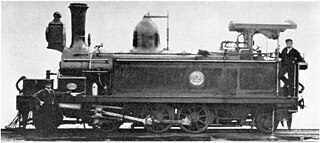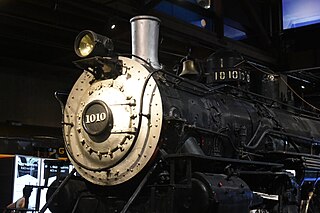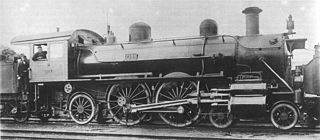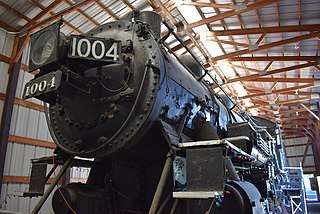
Baldwin Locomotive Works (BLW) was an American manufacturer of railway locomotives from 1825 to 1951. Originally located in Philadelphia, Pennsylvania, it moved to nearby Eddystone in the early 20th century. The company was for decades the world's largest producer of steam locomotives, but struggled to compete when demand switched to diesel locomotives. Baldwin produced the last of its 70,000-plus locomotives in 1951, before merging with the Lima-Hamilton Corporation on September 11, 1951, to form the Baldwin-Lima-Hamilton Corporation.

Under the Whyte notation for the classification of steam locomotives, 4-6-2 represents the wheel arrangement of four leading wheels on two axles, six powered and coupled driving wheels on three axles and two trailing wheels on one axle. The 4-6-2 locomotive became almost globally known as a Pacific type after a New Zealand locomotive that was shipped across the Pacific Ocean.
Under the Whyte notation for the classification of steam locomotives, 2-10-2 represents the wheel arrangement of two leading wheels, ten powered and coupled driving wheels, and two trailing wheels. In the United States and elsewhere the 2-10-2 is known as the Santa Fe type, after the Atchison, Topeka and Santa Fe Railway that first used the type in 1903.

4-4-0 is a locomotive type with a classification that uses the Whyte notation for the classification of steam locomotives by wheel arrangement and represents the arrangement: four leading wheels on two axles, four powered and coupled driving wheels on two axles, and a lack of trailing wheels. Due to the large number of the type that were produced and used in the United States, the 4-4-0 is most commonly known as the American type, but the type subsequently also became popular in the United Kingdom, where large numbers were produced.

A 4-6-0 steam locomotive, under the Whyte notation for the classification of steam locomotives by wheel arrangement, has four leading wheels on two axles in a leading bogie and six powered and coupled driving wheels on three axles with the absence of trailing wheels.

Under the Whyte notation for the classification of steam locomotives by wheel arrangement, 4-4-2 represents a configuration of a four-wheeled leading bogie, four powered and coupled driving wheels, and two trailing wheels supporting part of the weight of the boiler and firebox. This allows a larger firebox and boiler than the 4-4-0 configuration.

Under the Whyte notation for the classification of steam locomotives, 2-6-2 represents the wheel arrangement of two leading wheels, six coupled driving wheels and two trailing wheels. This arrangement is commonly called a Prairie.

Under the Whyte notation for the classification of steam locomotives, a 4-8-8-2 is a locomotive with four leading wheels, two sets of eight driving wheels, and a two-wheel trailing truck.

The Milwaukee Road's class EP-3 comprised ten electric locomotives built in 1919 by Baldwin and Westinghouse. They were nicknamed Quills because of their use of a quill drive. Although they were good haulers and well liked by engineers, poor design and constant mechanical problems plagued them for their entire lives and they were among the first of the Milwaukee Road's electric locomotives to be retired.

The N class were 12 steam locomotives that operated on the national rail network of New Zealand. They were built in three batches, including one batch of two engines for the private Wellington and Manawatu Railway Company, the WMR, by the Baldwin Locomotive Works in 1885, 1891, and 1901. Previously the N class designation had been applied between 1877 and 1879 to Lady Mordaunt, a member of the B class of 1874.

Atchison, Topeka and Santa Fe Railway No. 1010 is a 2-6-2 type steam locomotive built by the Baldwin Locomotive Works in 1901 for Atchison, Topeka and Santa Fe Railway. It started out as a Vauclain compound locomotive before it was rebuilt into a conventional locomotive in the 1910s. It was primarily used for various passenger trains across the Southwestern United States, including the record breaking 1905 Scott Special on the segment between Needles, California, and Seligman, Arizona, before it was reassigned to freight service in the 1940s. It was retired in 1955 and was kept by the Santa Fe for several years for preservation purposes. In 1979, Santa Fe donated No. 1010 to the California State Railroad Museum, where the locomotive resides there in Sacramento as of 2023.

The Denver and Rio Grande Western K-27 is a class of 3 ft narrow gauge 2-8-2 "Mikado" type steam locomotives built for the Denver and Rio Grande Railroad by the Baldwin Locomotive Works in 1903. Known by their nickname "Mudhens," they were the first and the most numerous of the four K classes of Rio Grande narrow gauge engines to be built. Of the original fleet of 15 locomotives, two survive to this day and operate on heritage railways in the United States. No. 463 is operational on the Cumbres and Toltec Scenic Railroad (C&TSRR) in Chama, New Mexico and No. 464 is currently out of service due to a rebuild on the Huckleberry Railroad in Genesee Township, Michigan.
A compound locomotive is a steam locomotive which is powered by a compound engine, a type of steam engine where steam is expanded in two or more stages. The locomotive was only one application of compounding. Two and three stages were used in ships, for example.
A triplex locomotive was a steam locomotive that divided the driving force on its wheels by using three pairs of cylinders to drive three sets of driving wheels. Any such locomotive will inevitably be articulated. All triplex locomotives built were of the Mallet type, but with an extra set of driving wheels under the tender. The concept was extended to locomotives with four, five or six sets of drive wheels. However, these locomotives were never built, except for one quadruplex locomotive in Belgium.

The Class S 2/5 locomotives operated by the Royal Bavarian State Railways included two express train, steam locomotives of American origin which were fitted with Vauclain compound engines.

The Vauclain compound was a type of compound steam locomotive that was briefly popular from the early 1890’s to the mid-1900’s. Developed by the Baldwin Locomotive Works, it featured two pistons moving in parallel, driving a common crosshead and controlled by a common valve gear using a single, complex piston valve.
The Victorian Railways V Class is a steam locomotive, used on the Victorian Railways in the period 1900-1930.

The WAGR Ec class was a class of 4-6-2 heavy passenger and goods Vauclain compound locomotives operated by the Western Australian Government Railways (WAGR) between 1901 and 1958.

Milwaukee Road 1004 is a preserved 4-6-0 steam locomotive built by Baldwin Locomotive Works in September 1901 as a class B4 four-cylinder Vauclain compound locomotive for the Milwaukee Road who numbered it 385.















